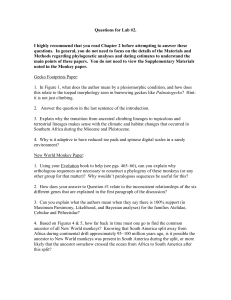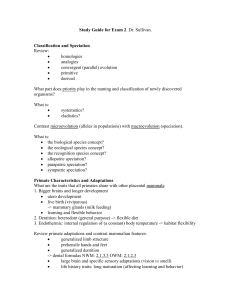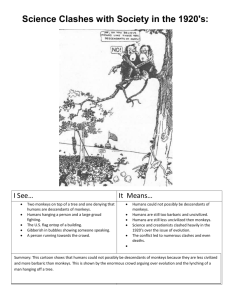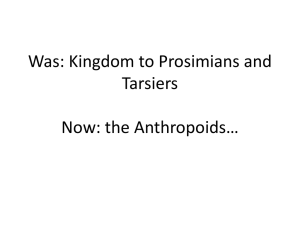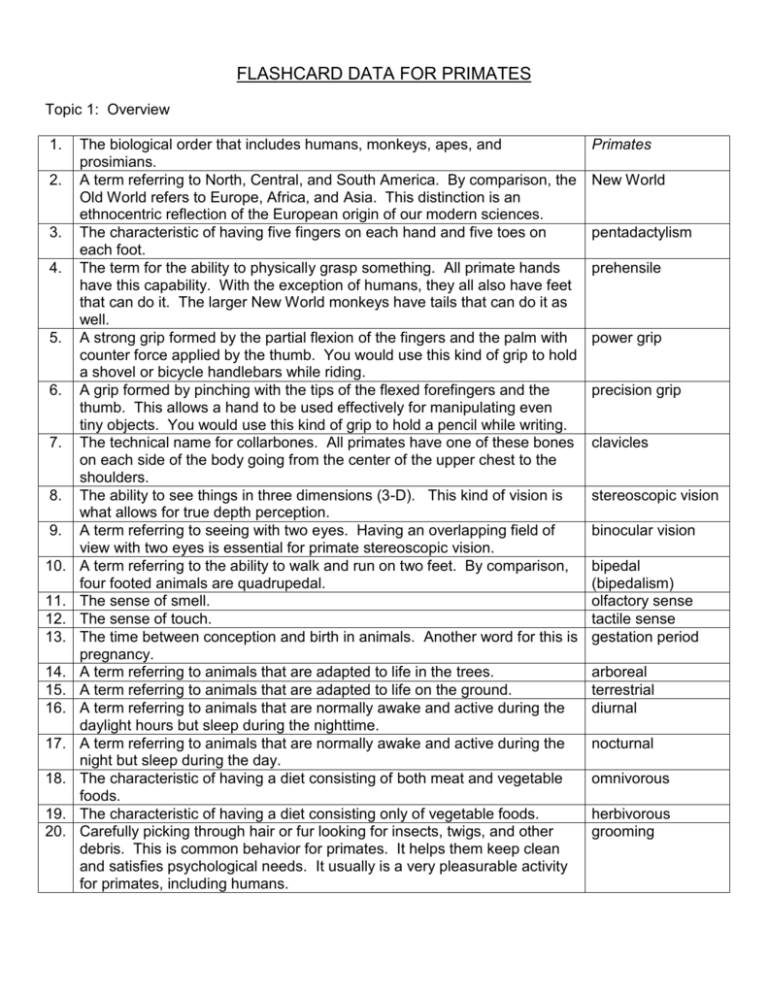
FLASHCARD DATA FOR PRIMATES
Topic 1: Overview
1.
2.
3.
4.
5.
6.
7.
8.
9.
10.
11.
12.
13.
14.
15.
16.
17.
18.
19.
20.
The biological order that includes humans, monkeys, apes, and
prosimians.
A term referring to North, Central, and South America. By comparison, the
Old World refers to Europe, Africa, and Asia. This distinction is an
ethnocentric reflection of the European origin of our modern sciences.
The characteristic of having five fingers on each hand and five toes on
each foot.
The term for the ability to physically grasp something. All primate hands
have this capability. With the exception of humans, they all also have feet
that can do it. The larger New World monkeys have tails that can do it as
well.
A strong grip formed by the partial flexion of the fingers and the palm with
counter force applied by the thumb. You would use this kind of grip to hold
a shovel or bicycle handlebars while riding.
A grip formed by pinching with the tips of the flexed forefingers and the
thumb. This allows a hand to be used effectively for manipulating even
tiny objects. You would use this kind of grip to hold a pencil while writing.
The technical name for collarbones. All primates have one of these bones
on each side of the body going from the center of the upper chest to the
shoulders.
The ability to see things in three dimensions (3-D). This kind of vision is
what allows for true depth perception.
A term referring to seeing with two eyes. Having an overlapping field of
view with two eyes is essential for primate stereoscopic vision.
A term referring to the ability to walk and run on two feet. By comparison,
four footed animals are quadrupedal.
The sense of smell.
The sense of touch.
The time between conception and birth in animals. Another word for this is
pregnancy.
A term referring to animals that are adapted to life in the trees.
A term referring to animals that are adapted to life on the ground.
A term referring to animals that are normally awake and active during the
daylight hours but sleep during the nighttime.
A term referring to animals that are normally awake and active during the
night but sleep during the day.
The characteristic of having a diet consisting of both meat and vegetable
foods.
The characteristic of having a diet consisting only of vegetable foods.
Carefully picking through hair or fur looking for insects, twigs, and other
debris. This is common behavior for primates. It helps them keep clean
and satisfies psychological needs. It usually is a very pleasurable activity
for primates, including humans.
Primates
New World
pentadactylism
prehensile
power grip
precision grip
clavicles
stereoscopic vision
binocular vision
bipedal
(bipedalism)
olfactory sense
tactile sense
gestation period
arboreal
terrestrial
diurnal
nocturnal
omnivorous
herbivorous
grooming
Topics 2-3: Prosimians
1. The primate suborder that includes the lemurs, lorises, and related animals.
This was the first suborder of primates to evolve.
2. The big island on which lemurs are found today. Along with a few small
neighboring islands, this is the only place in the world that lemurs have
survived in the wild.
3. The largest non-human Madagascar primate. During the early evening,
they mark their territories in the tree tops with loud, piercing vocalizations.
By doing this, they space themselves out in the forest. They are members
of the family Indriidae.
4. A species of Madagascar primates that have long spring-like legs that allow
them to jump over 30 feet from tree to tree. This evolutionary specialization
of their legs forces them to hop rather than walk when on the ground. They
are members of the Family Indriidae.
Prosimii
(prosimians)
Madagascar
5. A very rare, mostly solitary species of Madagascar primates that have
elongated, narrow fingers with claw-like compressed nails that are used,
along with their long, curved, rodent-like incisor teeth, to get at grubs under
tree bark and other hard to reach delicacies. They are the only members of
the family Daubentoniidae.
6. A South Asian prosimian in the superfamily Lorisoidea. They are about the
size of domesticated cats. They are slow, cautious climbers and creepers
on forest branches. They have unpleasant tasting poisonous saliva that
they lick onto their fur. Mothers also lick the fur of their babies which helps
to protect them from potential predators.
7. A small arboreal African prosimian in the superfamily Lorisoidea. They are
fast hoppers that can jump 30 times their own body length.
8. A close African relative of the Asian Loris. They are slow, cautious climbers
and creepers on forest branches like lorises.
9. Rat-sized primates from some of the islands off Southeast Asia.
Biochemically they are close to monkeys, but chromosomally they are
unique among the primates. They are the only members of the prosimian
infraorder (Tarsiformes). Unlike the lemurs, they lack a long snout and a
rhinarium, or moist, hairless pad at the end. They can rotate their heads
nearly 180°, like owls. They have long hairless tails, except for tuffs on the
end, like kangaroo rats.
aye-aye
indri
sifaka
loris
galago or bush
baby
potto or
angwantibo
tarsiers
Topic 4: Monkeys
1.
2.
3.
4.
The suborder that includes all of the monkeys, apes, and humans but not
the prosimians.
The infraorder of anthropoids that includes only the New World monkeys.
The infraorder of anthropoids that include only the Old World monkeys,
apes, and humans.
The term for the quantity of each type of tooth (incisor, canine, premolar,
and molar) in each quadrant of the mouth, counting from the front. For
humans, Old world monkeys, and apes it is 2.1.2.3.
Anthropoidea
(anthropoids)
Platyrrhini
Catarrhini
dental formula
5.
The type of mammal teeth that are used primarily for grinding and
smashing food. They are at the sides of your mouth.
6. The type of mammal teeth that are used like scissors for nipping off pieces
of food. They are at the front of your mouth.
7. The type of mammal teeth that are used for piercing and tearing. You
have one of these teeth in each quadrant of your mouth between the
incisors and premolars.
8. A term referring to animals that spend much of their day on the ground but
usually return to the trees to sleep.
9. A hairless, callused area on either side of the rump of some Old World
monkeys (e.g., macaques and baboons) and the small apes of Asia.
10. A nearly hairless large swollen patch of skin around the genital area that
becomes very prominent when females are in estrus. These areas swell
with fluids and turn bright pink or red due to hormonal changes that occur
in preparation for ovulation. They also produce odors that excite males of
the species. Males become highly attentive to the females at this time.
They are found among many of the Old World monkey species as well as
the chimpanzees and bonobos.
molar and
premolar
incisor
canine
semi-terrestrial
ischial callosity
sexual skin or
swelling
Topic 5: New World Monkeys
Topic 6: Old World Monkeys
1.
2.
3.
4.
5.
6.
The term that refers to a tail that can be used to grasp objects and even
support the body like a hand. Some of the New World monkeys have tails
with these capabilities, but none of the Old World primates have them.
The family of New World monkeys that includes the marmosets and
tamarins. They are the smallest of all monkeys. They are also considered
to be the most primitive monkeys in that their thumbs are not opposable,
they have claws on all digits except for their big toes, they lack the ability to
change their facial expressions, and twin births are common for
them. They do not have prehensile tails.
The family of New World primates that include squirrel, howler, spider,
capuchin, and many other monkey species. Some of them are as large as
medium-sized dogs, but most are smaller. Like the Old World monkeys,
they have nails on all of their fingers and toes. Some members of this
family have prehensile tails.
A skin surface that is sensitive to pressure, temperature, and pain because
there are high concentrations of nerve endings immediately below these
areas. The pad of skin with finger prints at the tip of your fingers is an
example.
The term referring to anatomical differences between males and females of
the same species. For example, non-human Primate males are usually
significantly larger and stronger than females.
The term referring to a stomach with "saccules," or sack-like
compartments, in which bacteria slowly break down cellulose in vegetable
foods, such as tough leaves, thereby providing more useable calories.
Among the primates, the colobus, langurs, and proboscis monkeys have
this characteristic. Cows and related animals also have it.
prehensile tail
Callitricidae
Cebidae
tactile pad
sexual dimorphism
sacculated
stomach
7.
8.
9.
10.
11.
12.
13.
The term for cheeks that are so elastic that they can expand to allow
temporary storage of food. Some of the Old World monkeys have this
characteristic as do hamsters and some other rodents.
The subfamily of Old World monkeys that includes the baboons,
mangabeys, mandrills, guenons, patas monkeys, and macaques. These
are all African species with the exception of the macaques which also live
in Asia and Gibraltar. Many of these species sleep in trees or on cliff faces
and spend their days in large groups foraging for food on grasslands.
Many of them also have ischial callosities, cheek pouches, and sexual
skins. They are omnivorous.
The subfamily of Old World monkeys that include the colobus of Africa and
the South Asian langurs and proboscis monkeys. All of them are
herbivores. They lack cheek pouches. They also share in common the
fact that they have sacculated stomachs and unusually long intestines that
increase the absorption of nutrients. These are all adaptations to a
predominantly low protein, fibrous leaf diet. Not surprisingly, they are also
referred to as the "leaf-eating monkeys."
A species in the family Cebidae. They are the largest New World
monkeys. Like the indris of Madagascar, they have developed the unusual
habit of defending territory in the branches of their forest canopies with
vocalizations. They do this with a specialized larynx and throat that
expands like a balloon. Their deep, throaty sound is extraordinarily loud.
A kind of small New World monkey whose favorite food is carbohydrate
rich tree sap which they tap by gnawing holes in trunks. Their territories
are centered on the trees that they regularly exploit in this way. Some eat
flower nectar as well.
The only New World monkey species known to use tools as an aid in
getting food. This monkey has the largest brain-to-body size ratio of any
primate other than humans.
A kind of South Asian monkey that has a sacculated stomach.
14. A kind of African monkey that has a sacculated stomach.
15. A kind of African monkey that has cheek pouches but not a sacculated
stomach.
16. The only member of the Cercopithecinae subfamily of Old World monkeys
that lives outside of Africa.
cheek pouches
Cercopithecinae
Colobinae
howler monkey
marmoset or
tamarin
capuchin
langur or proboscis
monkey
colobus monkey
baboon,
mangabey,
mandrill, guenon,
patas monkey, or
macaque
macaque
Topic 7: Apes
1.
The superfamily to which all apes and humans belong.
2.
3.
4.
The family of hominoids in which orangutans belong.
The family of hominoids in which gibbons belong.
The family of hominoids in which gorillas, chimpanzees, and bonobos
belong.
Hominoidea
(hominoids)
Hominidae
Hylobatidae
Hominidae
5.
The family of hominoids in which humans belong.
6.
The names of the “great apes.” These are the largest apes.
7.
8.
The names of the “lesser apes.” These are the smallest apes.
The names of the Asian ape species.
9.
The names of the African ape species.
10. The term for having only one mate at a time. This is rare among
nonhuman primates in general though it is common for gibbons and
siamangs.
11. The form of locomotion in which an animal travels through the trees by
swinging under branches with a hand over hand motion rather than running
along the top. The smaller apes and some New World monkeys do this.
12. The term for the type of family consisting of an adult male and female
mating pair along with their children.
13. The names of the ape species in which adults regularly defend their
territory against others with piercingly loud whooping and hooting
vocalizations.
14. The largest and most endangered Asian apes.
15. The largest African apes. They are also the largest primate species alive
today.
16. The best brachiators among the apes. Up to 90% of their locomotion is by
this means.
17. The least sexually dimorphic apes.
18. The apes that are knuckle walkers.
19. The only nonhuman primate that regularly engages in sexual intercourse
face to face. Both heterosexual and homosexual intercourse are also
common for this species. Copulation occurs frequently as a means of
reducing tension in their communities and has become recreational for
them.
20. The rarest of the 3 gorilla varieties or subspecies.
21. The African apes that hunt other animals for food—about 10% of their diet
consists of meat.
22. The most biologically successful of all apes in terms of the extent of their
geographic range and the size of their total population today.
Hominidae
(hominids)
orangutans,
gorillas,
chimpanzees, and
bonobos
gibbons
orangutans and
gibbons
gorillas,
chimpanzees, and
bonobos
monogamy
brachiation
(suspensory
climbing)
nuclear family
gibbons
orangutans
gorillas
gibbons
gibbons
gorillas,
chimpanzees, and
bonobos
bonobos
mountain gorillas
chimpanzees
chimpanzees
Topic 8. Humans
1,
The genus and species of all living humans today.
Homo sapiens
2.
The apes that humans are the most similar to in terms of our anatomy and
the closest to in our evolutionary past.
3.
The primate species that has the most varied and complex social
organizations. They are also the only primates to create and use symbols
as a means of communication.
The only primate species whose feet no longer have the ability to effectively
grasp and manipulate objects.
The most biologically successful of all primates in terms of the extent of
their geographic range and the size of their total population today.
4.
5.
Copyright © 2004-2012 by Dennis O'Neil. All rights reserved.
African apes,
especially the
chimpanzees and
bonobos
humans
humans
humans


